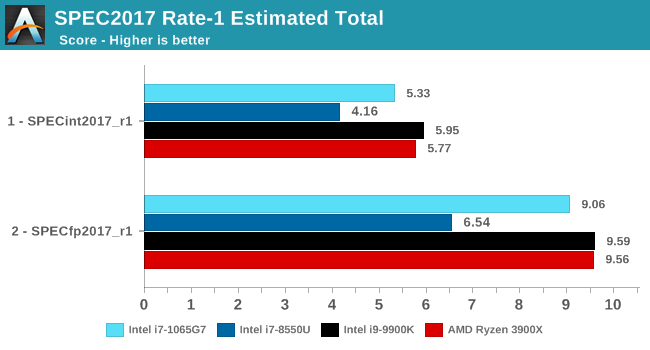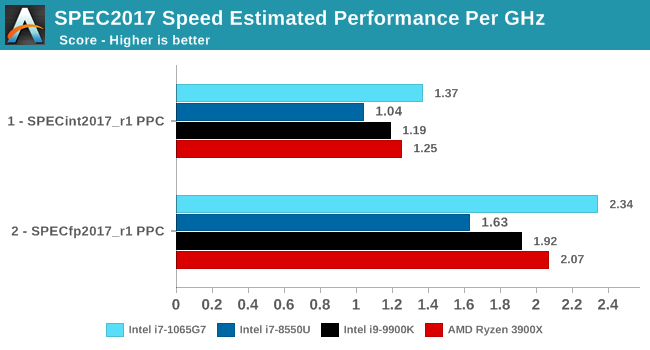The Ice Lake Benchmark Preview: Inside Intel's 10nm
by Dr. Ian Cutress on August 1, 2019 9:00 AM EST- Posted in
- CPUs
- Intel
- GPUs
- 10nm
- Core
- Ice Lake
- Cannon Lake
- Sunny Cove
- 10th Gen Core
Section by Andrei Frumusanu
SPEC2017 and SPEC2006 Results (15W)
SPEC2017 and SPEC2006 is a series of standardized tests used to probe the overall performance between different systems, different architectures, different microarchitectures, and setups. The code has to be compiled, and then the results can be submitted to an online database for comparsion. It covers a range of integer and floating point workloads, and can be very optimized for each CPU, so it is important to check how the benchmarks are being compiled and run.
We run the tests in a harness built through Windows Subsystem for Linux, developed by our own Andrei Frumusanu. WSL has some odd quirks, with one test not running due to a WSL fixed stack size, but for like-for-like testing is good enough. SPEC2006 is deprecated in favor of 2017, but remains an interesting comparison point in our data. Because our scores aren’t official submissions, as per SPEC guidelines we have to declare them as internal estimates from our part.
For compilers, we use LLVM both for C/C++ and Fortan tests, and for Fortran we’re using the Flang compiler. The rationale of using LLVM over GCC is better cross-platform comparisons to platforms that have only have LLVM support and future articles where we’ll investigate this aspect more. We’re not considering closed-sourced compilers such as MSVC or ICC.
clang version 8.0.0-svn350067-1~exp1+0~20181226174230.701~1.gbp6019f2 (trunk)
clang version 7.0.1 (ssh://git@github.com/flang-compiler/flang-driver.git
24bd54da5c41af04838bbe7b68f830840d47fc03)-Ofast -fomit-frame-pointer
-march=x86-64
-mtune=core-avx2
-mfma -mavx -mavx2
Our compiler flags are straightforward, with basic –Ofast and relevant ISA switches to allow for AVX2 instructions. Despite ICL supporting AVX-512, we have not currently implemented it, as it requires a much greater level of finesse with instruction packing. The best AVX-512 software uses hand-crafted intrinsics to provide the instructions, as per our 3PDM AVX-512 test later in the review.
For these comparisons, we will be picking out CPUs from across our dataset to provide context. Some of these might be higher power processors, it should be noted.
SPECint2006

Amongst SPECint2006, the one benchmark that really stands out beyond all the rest is the 473.astar. Here the new Sunny Cove core is showcasing some exceptional IPC gains, nearly doubling the performance over the 8550U even though it’s clocked 100MHz lower. The benchmark is extremely branch misprediction sensitive, and the only conclusion we can get to rationalise this increase is that the new branch predictors on Sunny Cove are doing an outstanding job and represent a massive improvement over Skylake.
456.hmmer and 464.h264ref are very execution bound and have the highest actual instructions per clock metrics in this suite. Here it’s very possible that Sunny Cove’s vastly increased out-of-order window is able to extract a lot more ILP out of the program and thus gain significant increases in IPC. It’s impressive that the 3.9GHz core here manages to match and outpace the 9900K’s 5GHz Skylake core.
Other benchmarks here which are limited by other µarch characteristics have various increases depending on the workload. Sunny Cove doubled L2 cache should certainly help with workloads like 403.gcc and others. However because we’re also memory latency limited on this platform the increases aren’t quite as large as we’d expect from a desktop variant of ICL.

In SPECfp2006, Sunny Cove’s wider out-of-order window can again be seen in tests such as 453.povray as the core is posting some impressive gains over the 8550U at similar clocks. 470.lbm is also instruction window as well as data store heavy – the core’s doubled store bandwidth here certainly helps it.

Overall in SPEC2006, the new i7-1065G7 beats a similarly clocked i7-8550U by a hefty 29% in the int suite and 34% in the fp suite. Of course this performance gap will be a lot smaller against 9th gen mobile H-parts at higher clocks, but these are also higher TDP products.
The 1065G7 comes quite close to the fastest desktop parts, however it’s likely it’ll need a desktop memory subsystem in order to catch up in total peak absolute performance.

Performance per clock increases on the new Sunny Cove architecture are outstandingly good. IPC increases against the mobile Skylake are 33 and 38% in the integer and fp suites, though we also have to keep in d mind these figures go beyond just the Sunny Cove architecture and also include improvements through the new LPDDR4X memory controllers.
Against a 9900K, although apples and oranges, we’re seeing 13% and 14% IPC increases. These figures likely would be higher on an eventual desktop Sunny Cove part.
SPEC2017



The SPEC2017 results look similar to the 2006 ones. Against the 8550U, we’re seeing grand performance uplifts, just shy of the best desktop processors.

Here the IPC increase also look extremely solid. In the SPECin2017 suite the Ice Lake part achieves a 14% increase over the 9900K, however we also see a very impressive 21% increase in the fp suite.
Overall in the 2017 suite, we’re seeing a 19% increase in IPC over the 9900K, which roughly matches Intel’s advertised metric of 18% IPC increase.










261 Comments
View All Comments
eastcoast_pete - Thursday, August 1, 2019 - link
Ian and Andrei, thanks for the article (Ian) and the tests (both) ! My take on why Intel did this "we let you play (test) with our reference system is that they needed to show that Ice Lake is for real, has working graphics, and not another gimped chip that is send off to pasture like Whiskey Lake. Overall, it seems to be an okay step forward, nothing great, but a step forward. For me, the main benefit of this new generation is AVX 512, which can speed certain programs up quite a lot.Lastly, Intel will sell a lot of these, mainly because AMD doesn't have a real competitive solution out there that can take them on in the low and lower power mobile space.
DooMMasteR - Friday, August 2, 2019 - link
Which makes this unusual showcase even weirder...Intel is so far only planning a low power mobile release (either because of platform restrictions, Ryzen has shown that 7nm needs complex thermal management) or because of fab volume restrictions in 10nm.
In either case Intels benefit from this showcase is quite small since AMD has no real contender announced anyways.
At least when people where looking for pure SoC performance... and in any other case AMD can still compete quite well, but lacks product variety and quality, Huawei has shown that amazing Ryzen mobile devices are possible and Lenovo and others have shown how to do it wrong.
The_Assimilator - Thursday, August 1, 2019 - link
While it's great that Intel is being so open about ICL, the sad thing is that it only highlights how bare their cupboard is at the moment. This is their second attempt at 10nm, yet it's so obviously inferior to the ultra-refined 14nm, which makes it clear that despite Intel's half-decade of massive expense and effort, their 10nm node isn't salvageable.I predict we'll see 14nm desktop ICL parts for Christmas, but I'm far more interested in what happens after 10nm. Does Intel have a plan to use all the hard-won experience on this failed node to make their next shrink actually happen on time and on schedule, or is the company in so deep that its decision-makers can't see any alternative route?
ksec - Thursday, August 1, 2019 - link
Just looking at those numbers, Icelake, while on average may be 20% faster, it is in fact some of the work load manage to get 30 to 40+% IPC increase. That is quite astonishing. And depending on AVX512 usage it could get even more performance out of it.What we need to know is die size.
GPU has improved but stilll isn't good enough.
Phynaz - Thursday, August 1, 2019 - link
Nothing from intel will ever be good enough for you unless it’s stamped AMDKorguz - Thursday, August 1, 2019 - link
and by your own comments so far in this thread, nothing will ever be good enough for you, unless its stamped intel, whats your point ?Phynaz - Friday, August 2, 2019 - link
I was waiting for you to show up. I’ll bet I’ve bought more AMD chips than you can count.Korguz - Friday, August 2, 2019 - link
you have ?? that's great, good for you, you must be proud of your self, knowing you have more money then brains. my self.. would prefer to pay my mortgage, food, and other things that are neededPhynaz - Saturday, August 3, 2019 - link
Sorry, I forgot you’re poor.Korguz - Saturday, August 3, 2019 - link
sorry phynaz, not poor. just have better things to spend my money on, cause unlike you, i dont still live with mommy and daddy, cause the way you insult people, and call them names, you must be some 15 year old, as this is what children do. maybe you should go away, grow up, and come back when you can talk to people with out resorting to insults, and childish behavior. 90% of your posts in this thread prove this, nothing but insults, does this make you feel better, calling people names and insulting them ?